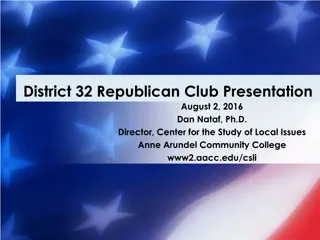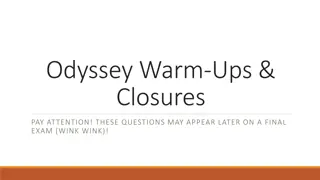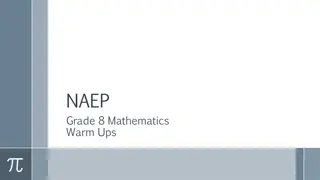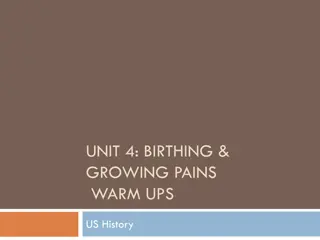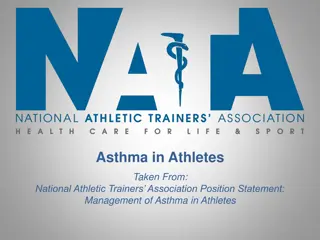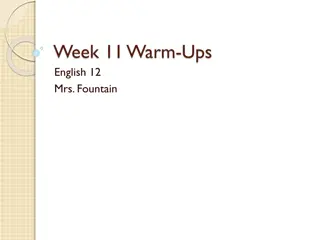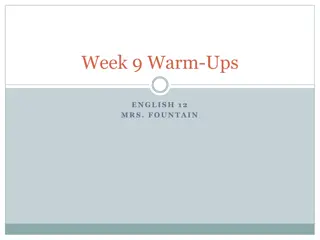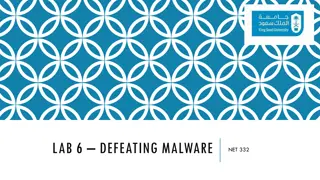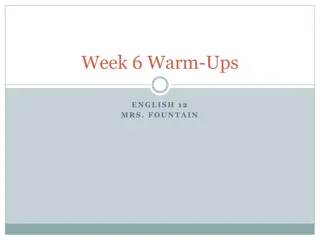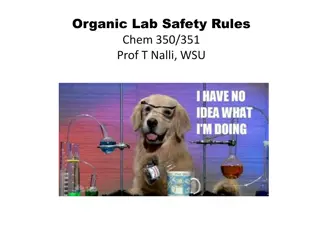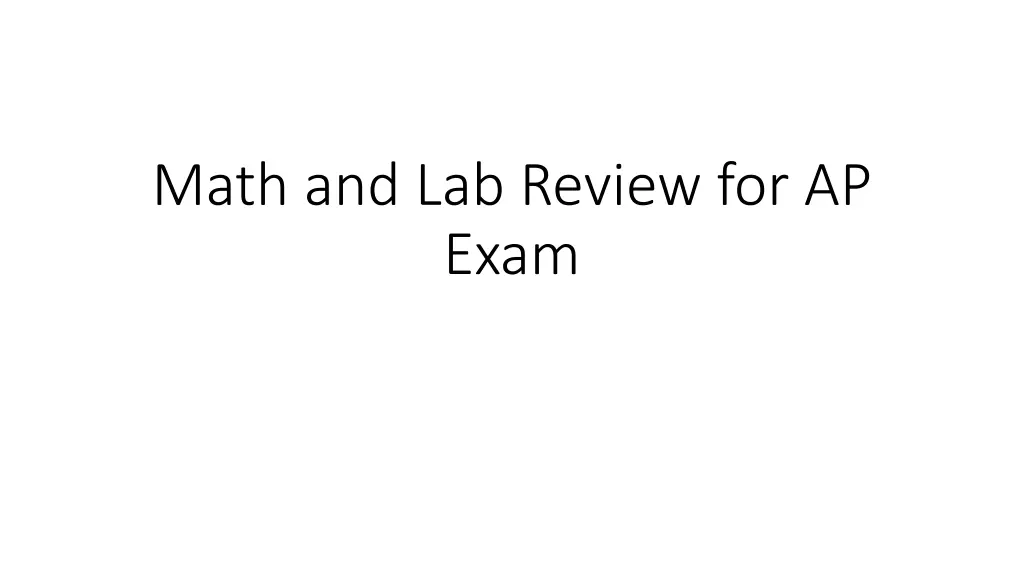
AP Exam Math and Lab Review: Solutions and Data Analysis
Enhance your preparation for the AP exam with detailed instructions on creating solutions and analyzing data sets. Learn to calculate concentrations, standard deviations, and chi-square values to excel in your math and lab review. Stay tuned for step-by-step guidance on Thursday's solutions, Tuesday's data analysis, and Wednesday's chi-square calculations.
Uploaded on | 1 Views
Download Presentation

Please find below an Image/Link to download the presentation.
The content on the website is provided AS IS for your information and personal use only. It may not be sold, licensed, or shared on other websites without obtaining consent from the author. If you encounter any issues during the download, it is possible that the publisher has removed the file from their server.
You are allowed to download the files provided on this website for personal or commercial use, subject to the condition that they are used lawfully. All files are the property of their respective owners.
The content on the website is provided AS IS for your information and personal use only. It may not be sold, licensed, or shared on other websites without obtaining consent from the author.
E N D
Presentation Transcript
Thursday, September 3rd Make a 1M solution of C7H11O4N3 Make a .5M solution of C7H11O4N3 Make a 1.5 M solution of C5H13NO3 Make a 2.0 M solution of C5H13NO3
Thursday, September 3rd Make a 1M solution of C7H11O4N3 Make a .5M solution of C7H11O4N3 Make a 1M solution of C7H11O4N3 C = 12 daltons x 7 = 84 H = 1 dalton x 11 = 11 O = 16 daltons x 4 =64 N = 14 daltons x 3 = So, dissolve 201g of C7H11O4N3 in water and fill it up to 1L to make a 1M solution. To make a .5M solution, dissolve 100.5g (201 x .5) in water and fill it up to the 1L mark. 42 201 g = molecular weight Make a 1.5 M solution of C5H13NO3 Make a 2 M solution of C5H13NO3 So, 135 x 1.5 = 202.5 so dissolve 202.5 g of C5H13NO3 in water and fill it up to 1L to make a 1.5 M solution. To make a 2 M solution, dissolve 270 g (135 x 2) in water and fill it up to the 1L mark. Make a 1.5M solution of C5H13NO3 C = 12 daltons x 5 = 60 H = 1 dalton x 13 = 13 O = 16 daltons x 3 =48 N = 14 daltons x 1 = 14 135 g = molecular weight
Tuesday, September 8th Calculate the standard deviation and standard error of the following data set (do NOT use a graphing calculator): 8 12 17 11 16 14
Tuesday, September 8th Calculate the standard deviation and standard error of the following data set (do NOT use a graphing calculator): Average (Mean) = 13 Deviation Squared TOTAL = 56 Number of groups 1 = 5 Total Deviation / 5 56/5 = 11.2 11.2 = 3.34 = STANDARD DEV Dev2 Obs Dev 8 8 5 25 12 12 1 1 17 17 4 16 11 11 2 4 16 16 3 9 = 3.34 / n = 3.34 / 6 = 3.34 / 2.4 = 1.4 = STANDARD ERROR 14 14 1 1
Wednesday, September 9th Calculate the chi square for the following data sets and determine whether the null hypothesis (there is no significant difference between the actual # of M&Ms in a bag and the expected #s based on the website) would be accepted or rejected. (Hint: figure out expected # for each color based on the % from the website!) This is an unpaired set. Color Distribution of Plain M&M s per bag according to MARS Brown 13% Yellow 14% Red 13% green 16% Blue 24% orange 20% Actual Number of Plain M&M s per bag Brown 24 Yellow 19 Red 32 green 17 Blue 22 orange 29 TOTAL 143
Wednesday, September 9th Color Distribution of Plain M&M s per bag according to MARS Brown 13% Yellow 14% Red 13% green 16% Blue 24% orange 20% Actual Number of Plain M&M s per bag Brown Yellow Red Green Blue Orange TOTAL 24 19 32 17 22 29 143 OBSERVED EXPECTED 18.6 20.0 18.6 22.9 34.3 28.6 143 X2 = (24-18.6)2/18.6 + (19-20) 2/20 + (32-18.6) 2/18.6 + (17-22.9) 2/22.9 + (22-34.3) 2/34.3 + (29-28.6) 2/28.6 X2 = 1.57 + .05 + 9.65 + 1.52 + 4.41 + .01 X2 = 17.21 n = 6, so n-1 = 5 (degrees of freedom) Critical Value of P for 5 is 11.07 17.21 > 11.07 so Null is REJECTED
Friday, September 25th Calculate the surface area, volume, and SA:Volume ratio for the following 3 cubes: Cube A sides are 3 cm Cube B sides are 9 cm Cube C sides are 5 cm
Friday, September 25th Surface Area = L x W x # of sides Volume = L x W x H Cube A SA = 3 x 3 x 6 = 54 cm2 SA : Vol Ratio = 54/27 = 2 Cube B SA = 9 x 9 x 6 = 486 cm2 SA: Vol Ratio = 486/729 = .67 Cube C SA = 5 x 5 x 6 = 150 cm2 SA : Vol Ratio = 150/125 = 1.2 The smaller the cube, the faster the full diffusion process will be Volume = 3 x 3 x 3 = 27 cm3 Volume = 9 x 9 x 9 = 729 cm3 Volume = 5 x 5 x 5 = 125cm3
Write a NULL HYPOTHESIS for the following 3 experiments: Monday, September 28th Experiment #1 A class of biology students is doing an experiment where they are looking at the Mendelian inheritance of two traits in pea plants. They are crossing peas that have white flowers and round seeds with plants that have purple flowers and wrinkled seeds. They will grow two generations of plants and then examine the F2 generation offspring to look at the ratios of each of the 4 different possible phenotypes to see if these two traits, flower color and seed shape, follow a Mendelian inheritance pattern. Experiment #2 A graduate student wants to examine how the process of germination effects a pea s ability to respire. He has three setups that compare glass beads (no respiration control), to the same volume of dry peas, to the same volume of germinating peas. He is going to measure how much oxygen they use up by putting them in vials attached to pipettes (which will contain air (oxygen) they can utilize) and submerging them in water for a 20 minute period. The more oxygen they utilize, the more respiration they are doing. Experiment #3 A scientist wants to see if the concentration of an enzyme makes a difference in the speed that a reaction is catalyzed. The enzyme catalase breaks down hydrogen peroxide (H202 ). The amount of H202 can be measured by using potassium permanganate which is a purple color, but when it combines with H202 , it turns clear. So, by adding different concentrations of a catalase solution to H202 and letting the reaction run for 30 seconds, then stopping the reaction and measuring how much H202 remains (by adding potassium permanganate), the scientist wants to see if there will be different amounts of H202 left depending on the concentration of the enzyme she used. Thus, the reaction would have run at different rates based on how much enzyme was added.
Monday, September 28th Experiment #1 A class of biology students is doing an experiment where they are looking at the Mendelian inheritance of two traits in pea plants. They are crossing peas that have white flowers and round seeds with plants that have purple flowers and wrinkled seeds. They will grow two generations of plants and then examine the F2 generation offspring to look at the ratios of each of the 4 different possible phenotypes to see if these two traits, flower color and seed shape, follow a Mendelian inheritance pattern. When examining the F2 generation of a cross of white/round and purple/wrinkled pea plants, the number of observed of each of the phenotypes will not be significantly different from the expected values which are predicted based on Mendelian inheritance. Experiment #2 A graduate student wants to examine how the process of germination effects a pea s ability to respire. He has three setups that compare glass beads (no respiration control), to the same volume of dry peas, to the same volume of germinating peas. He is going to measure how much oxygen they use up by putting them in vials attached to pipettes (which will contain air (oxygen) they can utilize) and submerging them in water for a 20 minute period. The more oxygen they utilize, the more respiration they are doing. When comparing the rates of respiration between germinating and non-germinating peas, there will be no significant difference in the amount of oxygen consumed between the two setups. Experiment #3 A scientist wants to see if the concentration of an enzyme makes a difference in the speed that a reaction is catalyzed. The enzyme catalase breaks down hydrogen peroxide (H202 ). The amount of H202 can be measured by using potassium permanganate, which is a purple color, but when it combines with H202 , it turns clear. So, by adding different concentrations of a catalase solution to H202 and letting the reaction run for 30 seconds, then stopping the reaction and measuring how much H202 remains (by adding potassium permanganate), the scientist wants to see if there will be different amounts of H202 left depending on the concentration of the enzyme she used. Thus, the reaction would have run at different rates based on how much enzyme was added. Varying the concentration of the enzyme catalase will have no significant effect on the rate of reaction in the breakdown of H202, and thus the amounts of H202 remaining will not be significantly different among the trials.
Tuesday, September 29th Calculate % change for the following sets of Data: Initial Mass (g) Final Mass (g) Cell A 18.5 g 12.5 g Cell B 13.7 18.9 g Cell C 14.3 17.1 g
Tuesday, September 29th % Change = (final initial)/initial mass x 100 Initial Mass (g)Final Mass (g) Cell A 18.5 g 12.5 g Cell B 13.7 18.9 g Cell C 14.3 17.1 g CELL A % Change = (12.5 18.5) x 100 = -32.4% 18.5 CELL B % Change = (18.9 13.7) x 100 = 38% 13.7 CELL C % Change = (17.1 14.3) x 100 = 19.6% 14.3
Thursday, October 1st Solve the following water potential problems: 1. If a cells S is -13.6 bars and the P is 7.4 bars, what is the ? 2. What is the of a 1.2M solution of NaCl at 22 C in an open beaker? 3. At 20 C, a cell containing 1.0 M sucrose is in equilibrium with its surrounding .4M solution of sucrose. What is the P of the cell? 4. At 25 C, a cell with a P of 7.6 bars is in equilibrium with the surrounding 0.8M solution of glucose in an open beaker. What is the molar concentration of glucose in the cell?
Thursday, October 1st Solve the following water potential problems: 1. If a cells S is -13.6 bars and the P is 7.4 bars, what is the ? = S + P = -13.6 + 7.4 = -6.2 bars 2. What is the of a 1.2M solution of NaCl at 22 C in an open beaker? S = -iCRT = -(2)(1.2)(.0831)(295) = -58.8 bars 3. At 20 C, a cell containing 1.0 M sucrose is in equilibrium with its surrounding .4M solution of sucrose. What is the P of the cell? Solution S = -iCRT = -(1)(.4)(.0831)(293) = -9.7 bars Cell S = -iCRT = -(1)(1.0)(.0831)(293) = -24.3 bars = S + P -9.7 = -24.3 + P 14.6 = P
Thursday, October 1st 4. At 25 C, a cell with a P of 7.6 bars is in equilibrium with the surrounding 0.8M solution of glucose in an open beaker. What is the molar concentration of glucose in the cell? Solution S = -iCRT = -(1)(.8)(.0831)(298) = -19.8 bars = S + P -19.8 = S + 7.6 -27.4 = S Cell S = -iCRT -27.4 = -(1)(C)(.0831)(298) -27.4 = -24.7 (C) 1.1M = C
Tuesday, October 6th Using the graph, calculate RATE of mass change for Cell A from 0-40 seconds Using the data table, calculate the % change for the potato core in the purple solution
Tuesday, October 6th Using the graph, calculate RATE of mass change for Cell A from 0-40 seconds RATE of change in mass = y / x = (3-0)/(40-0) = 3/40 = .075 Using the data table, calculate the % change for the potato core in the purple solution % Change = (final initial)/initial x 100 = (5.1-4.7)/4.7 x 100 = 8.5%
Friday, October 9th In this experiment, the amount of product produced was measured. Calculate the rate of reaction for the following time points: 0-30 seconds 30-40 seconds 40-60 seconds What does this graph (and your calculations) tell you about the rate of reaction? Explain what the active site and the allosteric site is on an enzyme. Differentiate between competitive inhibition and non- competitive inhibition
Friday, October 9th 0-30 seconds 16 0 / 30-0 = 16/30 = .53 30-40 seconds 18-16 / 40-30 = 2/10 = .2 40-60 seconds 18-18 / 60-40 = 0/20 = 0 What does this graph (and your calculations tell you about the rate of reaction? This tells us that the rate of reaction is highest in the beginning of the experiment; this is because there is the most amount of substrate Active Site the part of the enzyme that reacts with the substrate Allosteric Site the part on the enzyme where non-competitive inhibitors bind to; different from the active site Competitive Inhibition when the inhibitor competes with the substrate for the active site; by increasing the substrate concentration, competitive inhibition can be overcome Non-competitive Inhibition when the inhibitor binds to the allosteric site and therefore changes the shape of the active site so the substrate cannot bind
Monday, October 12th Think about the enzyme lab. Explain the function of each of the following components in the experiment: Catalase H2SO4 KMnO4 H2O2
Monday, October 12th Think about the enzyme lab. Explain the function of each of the following components in the experiment: Catalase enzyme that breaks down hydrogen peroxide; found in cells because hydrogen peroxide is produced as a byproduct and can be toxic to cells, so the catalase breaks it down into non-toxic substances (water and oxygen gas) H2SO4 ACID!; used to stop the reaction at specific times by denaturing the enzyme KMnO4 potassium permanganate; allowed us to determine how much hydrogen peroxide was left in the sample H2O2 was the substrate for the chemical reaction; got broken down by the catalase
Monday, October 19th Answer the following questions about the cellular respiration lab: What are the two variables we are examining? Which respirometer would you expect to show the most respiration? What is the equation for cellular respiration? What is the difference between germinating and non-germinating seeds?
Monday, October 19th Answer the following questions about the cellular respiration lab: What are the two variables we are examining? Germinating vs. non-germinating and temperature Which respirometer would you expect to show the most respiration? The respirometer in the warmer water that contains the germinating peas What is the equation for cellular respiration? 6O2 + C6H12O6 6CO2 + 6 H20 + ATP What is the difference between germinating and non-germinating seeds? Germinating means actively growing and non-germinating means that the pea is dry and dormant
Tuesday, November 3rd Refer to Part A of the Mitosis/ Meiosis Lab you did yesterday 1. What phase of the cell cycle do cells spend most of their time in? 2. What phase of mitosis do cells spend most of their time in? 3. If a cell has 32 chromosomes in prophase, how many chromosomes does it technically have in anaphase? 4. If a cell has 32 chromosomes in prophase, how many chromosomes does each new cell have after cytokinesis?
Tuesday, November 3rd Refer to Part A of the Mitosis/ Meiosis Lab you did yesterday 1. What phase of the cell cycle do cells spend most of their time in? interphase 2. What phase of mitosis do cells spend most of their time in? prophase 3. If a cell has 32 chromosomes in prophase, how many chromosomes does it technically have in anaphase? 64 4. If a cell has 32 chromosomes in prophase, how many chromosomes does each new cell have after cytokinesis? 32
Wednesday, November 4th A Label each of the letters in this onion root tip as Prophase, Metaphase, Anaphase, Telophase, or Interphase. B C D E
Friday, November 6th If you observed 150 cells and 30 were in prophase, what percentage of cells are in prophase? If that type of cell took an hour and a half to go through the cell cycle, how long would it spend in prophase? If two genes crossed over 25% of the time, how many map units apart they? Which of the following Sordaria asci structures have crossed over?
Friday, November 6th If you observed 150 cells and 30 were in prophase, what percentage of cells are in prophase? 20% If that type of cell took an hour and a half to go through the cell cycle, how long would it spend in prophase? 18 minutes If two genes crossed over 25% of the time, how many map units apart they? 25 map units apart we will talk about this one! Which of the following Sordaria asci structures have crossed over? All but the last one!
Friday, November 13th What are the chances that if 3 coins are flipped, they will all land on heads? What are the chances that if 3 coins are flipped, two will land on heads and one will land on tails?
Friday, November 13th What are the chances that if 3 coins are flipped, they will all land on heads? 1/8 x x = 1/8 What are the chances that if 3 coins are flipped, two will land on heads and one will land on tails? 3/8 H H T x x = 1/8 T H H x x = 1/8 H T H x x = 1/8 3/8
Monday, November 16th If your parents are AaBbDD x aaBbDd What are the chances that you would get an offspring that: 1. is heterozygous for all 3 traits? 2. is heterozygous for at least 2 traits? 3. is homozygous dominant for at least two traits?
Monday, November 16th If your parents are AaBbDD x aaBbDd 1. is heterozygous for all 3 traits? AaBbDd x x = 1/8 2. is heterozygous for at least 2 traits? AaBbDD x x = 1/8 = 2/16 AaBbDd x x = 1/8 = 2/16 AaBBDd x x = 1/16 AabbDd x x = 1/16 aaBbDd x x = 1/8 = 2/16 8/16 = 1/2 3. is homozygous dominant for at least two traits? AaBBDD x x = 1/16 aaBBDD x x = 1/16 2/16 = 1/8
Thursday , November 19th Purple kernels (A) are dominant to yellow ones (a) and smooth kernels (B) are dominant to wrinkled ones (b). For both sets of data below (one monohybrid, one dihybrid), make a punnet square to determine the expected numbers, then do chi square to determine if the genes are linked or not (if chi square is rejected, genes are linked). Remember that the p value for a monohybrid cross is 3.84 and the p value for a dihybrid cross is 7.82 Cross #1 2 individuals heterozygous for kernel color Cross #2 an individual heterozygous for both traits crossed with an organism homozygous recessive CROSS #2 DATA: CROSS #1 DATA: Purple, Smooth Purple, Wrinkled Yellow, Smooth Yellow, Wrinkled Total # Kernels Purple Yellow Total # Kernels Observed 415 153 568 Observed 86 79 81 76 322 Expected Expected
Thursday , November 19th Purple kernels (A) are dominant to yellow ones (a) and smooth kernels (B) are dominant to wrinkled ones (b). Cross #1 2 individuals heterozygous for kernel color Aa x Aa A a Purple 568 x .75 = 426 A AA Aa Yellow 568 x .25 = 142 a Aa aa x2 = (415-426) 2 + (153-142) 2 426 x2 = .28 + .85 x2 = 1.13 142 Null Hypothesis is ACCEPTED b/c 1.13 < 3.84 Therefore, genes are NOT linked CROSS #1 DATA: Purple Yellow Total # Kernels Observed 415 153 568 Expected 426 142 568
Thursday , November 19th Purple kernels (A) are dominant to yellow ones (a) and smooth kernels (B) are dominant to wrinkled ones (b). Cross #2 an individual heterozygous for both traits crossed with an organism homozygous recessive AaBb x aabb AB Ab aB AaBb Purple, smooth Aabb Purple, wrinkled aaBb yellow, smooth aabb yellow, wrinkled ab AB Ab aB ab ab x2 = (86-80.5)2 + (79-80.5) 2 + (81-80.5) 2 + (76-80.5)2 80.5 80.5 x2 = .38 + .03 + .003 + .25 ab AaBb Aabb aaBb aabb 80.5 x2 = .663 80.5 CROSS #2 DATA: Because .663 < 7.82, the Null Hypothesis is accepted; therefore the genes are NOT linked Purple, Smooth Purple, Wrinkled Yellow, Smooth Yellow, Wrinkled Total # Kernels Observed 86 79 81 76 322 Expected 80.5 80.5 80.5 80.5 322
Friday, November 20th 1. If you have two individuals, AaBBccDdEe x aabbCCDdEe, what is the probability of getting an individual who is completely heterozygous? 2. If you have those same parents, what is the probability of getting the following individuals: aaBbCcddee AaBbCcDdEE AaBBCcDDEe 3. If you have AaBb x AaBb, what is the expected ratio of phenotypes for the offspring? (A- purple, a yellow, B- tall, b short) If you have 1000 individuals, how many would you expect to be purple and short? 4. If you had the following individual, how many different types of gametes would he/she be able to make? AABbccDdEeffGGHh 5. If two genes cross over 50% of the time, what do you know about their location?
Friday, November 20th 1. If you have two individuals, AaBBccDdEe x aabbCCDdEe, what is the probability of getting an individual who is completely heterozygous? AaBbCcDdEe x 1 x 1 x x = 1/8 2. If you have those same parents, what is the probability of getting the following individuals: aaBbCcddee x 1 x 1 x x = 1/32 AaBbCcDdEE x 1 x 1 x x = 1/16 AaBBCcDDEe x 0 x 1 x x = 0
Friday, November 20th 3. If you have AaBb x AaBb, what is the expected ratio of phenotypes for the offspring? (A- purple, a yellow, B- tall, b short) If you have 1000 individuals, how many would you expect to be purple and short? Ratio = 9:3:3:1 so 3/16 would show one dominant trait, and one recessive 1000/16 = 62.5 x 3 = 187.5 4. If you had the following individual, how many different types of gametes would he/she be able to make? AABbccDdEeffGGHh See how many genes are heterozygous and it is 2 to that number B, D, E, H are all heterozygous, so 24 = 16 possible gametes 5. If two genes cross over 50% of the time, what do you know about their location? They are located on different chromosomes
This is a picture of a plasmid. A plasmid is an extra piece of DNA found in prokaryotes (and some eukaryotes). This plasmid is 6354 base pairs long. Wednesday, December 16th If you used a restriction enzyme (which is an enzyme that cuts at a specific point) that cut at NgoMIV and BamHI, what size pieces of DNA would you have? If you used restriction enzymes that cut at Acc651, BgIII, and PspOMI, what size pieces would you have?
If you used a restriction enzyme (which is an enzyme that cuts at a specific point) that cut at NgoMIV and BamHI, what size pieces of DNA would you have? Cut at 329 and 1436, so 1436-329 = 1107 And then 6354 1107 = 5247 Wednesday, December 16th If you used restriction enzymes that cut at Acc651, BgIII, and PspOMI, what size pieces would you have? Cut at 652, 726, and 2990, so you would have 3 pieces 74, 2264, 4016 726 652 = 2990 726 = 2264 6354-2338 = 4016 74 2338
Thursday, December 17th A C D B 4 2 3 1 1. Look at the gel to the left. Are the wells at the positive end or the negative end and why? 2. Look at the piece of DNA above that has been digested with a restriction enzyme. Which lane would have the digested piece of DNA in it? 3. Based on the SIZE of the fragment of DNA, the band closest to the well would represent which fragment? (which letter?) 4. Based on the SIZE of the fragment of DNA, the band furthest from the well would represent which fragment? (which letter?) 5. Which lane would represent the piece of DNA if it had NOT been digested by the enzyme?
Thursday, December 17th A C D B 1. Look at the gel to the left. Are the wells at the positive end or the negative end and why? Negative end b/c DNA is negative and will run towards the positive side 2. Look at the piece of DNA above that has been digested with a restriction enzyme. Which lane would have the digested piece of DNA in it? Lane 1 3. Based on the SIZE of the fragment of DNA, the band closest to the well would represent which fragment? (which letter?) Fragment B (largest travels the slowest) 4. Based on the SIZE of the fragment of DNA, the band furthest from the well would represent which fragment? (which letter?) Fragment A (smallest travels the fastest) 5. Which lane would represent the piece of DNA if it had NOT been digested by the enzyme? Lane 3 4 2 3 1
Friday, December 18th 1. Look at the gel. Which suspect committed the crime? 2. If you had 5 pieces of DNA with the following sizes: 3,452bp, 9,432 bp, 12,473 bp, 1,342bp, and 5,938bp which one would travel the furthest from the well? Which one would be found closest to the well? Look at the piece of DNA below. Write the complementary strand. Imagine that it is digested with SmaI and HbaI. How many fragments would it produce? Does SmaI produce blunt or sticky ends? What about HbaI? 3. 4. 5 A G C G C T T T A G A C C C G G G A T G G A C C A G C G C A T G A C G C G C C C T 3
Friday, December 18th 1. Look at the gel. Which suspect committed the crime? Suspect 3 2. If you had 5 pieces of DNA with the following sizes: 3,452bp, 9,432 bp, 12,473 bp, 1,342bp, and 5,938bp which one would travel the furthest from the well? 1,342 bp. Which one would be found closest to the well? 12,473 bp 3. Look at the piece of DNA below. Write the complementary strand. Imagine that it is digested with SmaI and HbaI. How many fragments would it produce? 5 4. Does SmaI produce blunt or sticky ends? Blunt What about HbaI? Sticky 5 A G C G C T T T A G A C C C G G G A T G G A C C A G C G C A T G A C G C G C C C T 3 3 T C G C G A A A T C T G G G C C C T A C C T G G T C G C G T A C T G C G C G G G A 5
Thursday, January 7th Complete the following Hardy Weinberg Problems: 1. In a population of 1000 mice, 184 were white and the rest were black. If the black color is dominant, how many were heterozygous? What is the allele frequency of the recessive allele? 2. In a flower population, red is dominant to white. Out of 500 plants, there are 423 red ones. What is the allele frequency of the dominant allele? How many flowers are homozygous dominant? 3. In a population of pea plants, round seeds are dominant to wrinkled. If you have 150 plants, and you know the frequency of the recessive allele is .3, how many plants are heterozygous?
Thursday, January 7th 1. In a population of 1000 mice, 184 were white and the rest were black. If the black color is dominant, how many were heterozygous? What is the allele frequency of the recessive allele? 184/1000 = .184 = q2 q = .43 p2 + 2pq + q2 = 1 (.57) 2 + 2(.57)(.43) + (.43) 2 = 1 p = .57 .32 + .49 + .18 = 1 So .heterozygotes = .49 x 1000 = 490 Allele Frequency of Recessive allele (q) = .43 2. In a flower population, red is dominant to white. Out of 500 plants, there are 423 red ones. What is the allele frequency of the dominant allele? How many flowers are homozygous dominant? 500-423 = 77 white 77/500 = .15 = q2 p2 + 2pq + q2 = 1 (.61) 2 + 2(.61)(.39) + (.39) 2 = 1 q = .39 p = .61 .37 + .48 + .15 = 1 Allele Frequency of Dominant allele (p) = .61 So .homozygous dominant = .37 x 500 = 185
Thursday, January 7th In a population of pea plants, round seeds are dominant to wrinkled. If you have 150 plants, and you know the frequency of the recessive allele is .3, how many plants are heterozygous? q = .3 p = .7 p2 + 2pq + q2 = 1 (.7) 2 + 2(.7)(.3) + (.3) 2 = 1 .49 + .42 + .09 = 1 So .heterozygotes = .42 x 150 = 63
Wednesday, January 13th LB/ara -pGLO LB/amp/ara +pGLO LB/amp pGLO LB/amp +pGLO What is the general goal of the Transformation lab? What plasmid are we using? What genes are found on the plasmid? What is the role of arabinose? Fill in the following table: Would you expect bacteria to grow on these plates? Why or Why not? Would you expect the bacteria on this plate to be transformed? If bacteria grew on this plate, would it glow? Why or why not?



